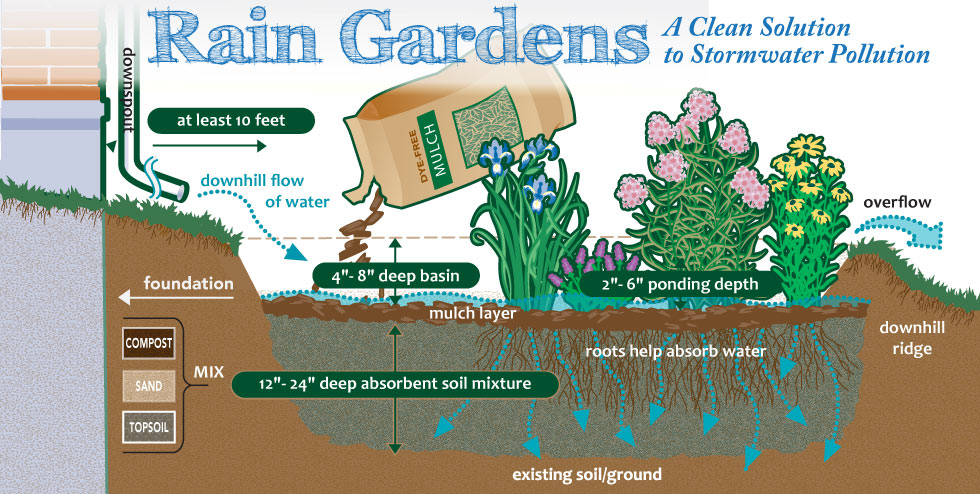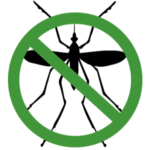
Rain gardens are a natural and beautiful way to help your streams. These gardens in slight depressions in the ground trap rainfall from a roof or driveway and prevent it from adding to the polluted runoff that damages streams. Trapped rain water is allowed to slowly sink into the ground while supporting beautiful plants that attract birds and butterflies. You can create your own rain garden in 3 easy steps…
1. Pick the Right Location and Size
The best locations are in natural depressions or low lying areas where water flows naturally from a downspout, driveway, patio or sidewalk. Avoid steep slopes and areas near septic systems or drinking water wells. You must be able to move water from the hard surface (roof, etc.) to the garden location, either by directing a downspout with an extended tube towards it, or simply by following contours and capturing water that is naturally flowing downhill.
Click here for more detailed information about picking the right location
 A properly sited and prepared rain garden will not allow mosquitoes to breed. Your rain garden will drain within 24-48 hours after a storm. Mosquitoes need seven days or more to complete a breeding cycle.
A properly sited and prepared rain garden will not allow mosquitoes to breed. Your rain garden will drain within 24-48 hours after a storm. Mosquitoes need seven days or more to complete a breeding cycle.
2. Create a Design and Select Plants
Once you have a location and size for your garden, sketch it out on paper. Determine the mix of species you would like to use, including flowers, grasses, and shrubs that are drought tolerant but can withstand wet conditions. Native plants are adapted to local conditions, easy to maintain and attract birds and butterflies. Fill in your sketch with your selected plants.
Click here for more detailed information about design and plant selection
3. Construct and Plant your Garden
Spray paint or otherwise mark on the ground the exact shape of your rain garden. Excavate to a depth of 4-8 inches, creating a berm on the downslope side of your garden using the removed sod. Amend your soil as needed to improve drainage. Try to keep the bottom of the basin as flat as possible to increase the area that will come in contact with water regularly. Add plants following your design, placing species that need the most water in the lowest lying areas or in the most direct path from the downspout.
Click here for more detailed information about constructing and planting your rain garden
Rain Garden Plants
 By using native plants in your rain garden you are giving your plants the best chance to survive the wide range of weather conditions they will experience, from long droughts to large storms. Native plants also support the largest number of wildlife species, including birds, butterflies, and bees.
By using native plants in your rain garden you are giving your plants the best chance to survive the wide range of weather conditions they will experience, from long droughts to large storms. Native plants also support the largest number of wildlife species, including birds, butterflies, and bees.
Click here for more detailed information about selecting the right plants
SPONSORS
This project has been funded by the League of Women Voters of Pennsylvania Citizen Education Fund through a Section 319 federal Clean Water Act grant from the Pennsylvania Department of Environmental Protection, administered by the U.S. Environmental Protection Agency.
CREDITS
Special thanks to the Partnership for the Delaware Estuary and the Philadelphia Water Department for the graphics. Artwork © 2013 by Frank McShane, Merle Manwaring and www.vectoropenstock.com
